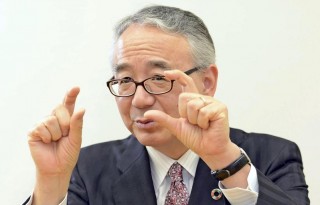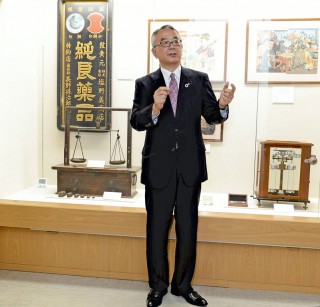Loading
Search
▼ R&D Means Good Medicine At Low Prices / Focus On Strength Of Expertise
- Category:Other
While large-scale corporate acquisitions in the pharmaceutical industry have taken place globally one after another, Osaka city-based Shionogi & Co., Ltd. has pursued a different path by focusing on research and development — rather than on expanding its business scale — and enjoyed a top level of profitability in the industry. For this installment of Leaders, a column featuring corporate management and senior executives, President and CEO Isao Teshirogi explains his business philosophy and approach to success to The Yomiuri Shimbun.
To simply describe what patients want from medicine is: “Good products at low prices.” This is an absolute business principle and a strong one among Osaka area merchants.
Developing a new drug takes 10 to 15 years, however, and the odds of turning a chemical compound into a product are extremely low — one in 25,000. Even if we are able to put a new drug on the market, the patent expires 20 years from the patent application and we then face a “patent cliff” problem, that is, a sharp drop in revenues that follows the sales of generic versions of the drug. This issue shows how difficult it is to manage a pharmaceutical company.
Given the circumstances, how do we provide drugs at low prices? The higher the cost of research and development, the more money required to recover the investment. The only choice we have is to sell a lot of product or raise the price. How to minimize R&D costs is crucial. We should streamline our business operations as much as possible through outsourcing sales, maybe even production, along with clearly defining what we do in-house and make it more efficient. Such clear distinctions are necessary.
If we purely take such an approach, the business will take the form of a start-up. However, increasing the volume of a chemical compound initially produced in test tubes to 1 kilogram, 1 ton, 10 tons is extremely difficult. This is the point where major pharmaceutical companies, or “mega pharma,” are at an advantage. In my view, Shionogi is a hybrid type of company that operates somewhere in between a start-up and a mega pharma.
With that, we believe it is important to continue to be a drug discovery-based pharmaceutical company. That is because, if we could continue to produce new drugs with our own, we are able to achieve both high profitability and provide drugs at reasonable prices.
In fact, there is a lot I can’t explain if asked “what is needed to produce medicine?” It used to be said: “R&D of a new drug requires ¥100 billion annually. Therefore, a pharmaceutical company can’t survive without having annual sales on the scale of ¥500 billion.” That was one of the reasons why we saw large-scale mergers of pharmaceutical firms in the 2000s. However, if we look at their businesses after the mergers, spending on R&D is not proportionate to the successful development of new drugs.
[Xofluza, a flu medicine Shionogi put on the market in 2018, was discovered during the research process for another drug.]
We have expertise in the field of infectious diseases and developed the HIV drug dolutegravir. We encountered a series of failures in developing it. I was in charge of the R&D division and the president told me many times, “That’s enough!” We finally succeeded in 2008 after I asked the president, “Let me try one more time.” It took us about 10 years to develop the drug.
A part of the chemical compound structure — we found it after finally breaking the wall in our long battle against HIV — helped us develop Xofluza. If we had not struggled to develop the HIV drug, we could not have created Xofluza.
Luck plays a part in medical discovery. The important thing, however, is to determine what must be abandoned and maximize the strengths of one’s specialty. I believe that leaders should deeply commit to setting priorities.
Reform to change mind-set
When I became president, the company was struggling and I had to wrestle with structural reforms.
[Although both Shionogi’s net sales and operating income ranked third in the industry in 1985, its net sales rank plunged to 10th in 2010 and the operating income also fell to much lower.]
What happens when a company that became third in the industry takes a dive to 10th place? Long-time employees complained: “We’re great. It’s poor management that led us to this predicament.” Young employees said plainly, “The company did not hire us with high expectations.”
I decided to make all-out efforts to regain the reputation and profile of a prestigious company, no matter how long it might take.
I started emailing a memo about 20 pages long to describe the situation the company was facing to all employees once every three months. The first time, less than 50 percent of employees opened it, although a notice of personnel reassignment emailed at the same time was read by 99 percent of them. They paid attention to personnel affairs, but not to the business situation of the company.
That being the case, I took another action. I gathered early-career employees from a wide range of divisions such as R&D, production and sales for dialogue sessions. During a two-hour meeting, however, not a single question was asked. I learned afterward that their bosses told them, “Do not ask unnecessary things to the president, it might have a negative impact on my career.” Mid-level managers shun open discussions. This is a typical phenomenon in poorly performing companies. It took three or four years to change the employees’ mind-sets.
Prior to assuming the presidency, I reviewed our R&D system. Our laboratory used to be derisively called “Shionogi University” and was considered, to the point of ridicule, a free-spirited place where people were less inclined to make good products than to conduct interesting research, write good papers and take up chairman positions in academic societies.
We were not able to be competitive in that way. I slashed the number of research fields from 20 to 30 down to three, including infectious disease research. I faced some resistance, but pushing ahead with a “selection and concentration” approach has led us to where we stand today.
Respond to consumers’ concern
I studied pharmaceutical sciences at university. While 95 percent of the students went on to graduate school, I chose to work for a company. I did not like doing research. I joined Shionogi hoping to work in sales.
Although I was instead assigned to the development section, I enjoyed my work, which was different from research work wearing a white coat and handling test tubes. I was posted to the United States twice. On the second posting, I was assigned to a company selling capsules for medicine. I was thinking I wouldn’t last at that job because I had been happy with my product development work.
But after start working there, I realized all the employees were working very hard. Amid a difficult business environment, the accounting staff was busy managing things and senior executives were encouraging the employees.
I keenly felt that managing an organization requires solid determination. Without that experience, I would have had the wrong idea that “all I have to do is R&D,” and I would have a different business perspective from the one I have now.
[Teshirogi became president last year of the industry group the Federation of Pharmaceutical Manufacturers’ Association of Japan.]
We have to admit that our industry has up to now failed to fully explain itself.
On a global standard, Japan’s universal health insurance coverage system is incredibly beneficial to patients. However, what patients do is tell their symptoms to their doctors, get tested and take the medicine the doctors prescribe. Because there is a huge gap in knowledge between doctors and patients, an interactive dialogue is difficult between them. Such a relationship gives patients little incentive to be more knowledgeable about their medicine intake.
As the population composition advances into a higher age bracket, however, the issue of who should bear the cost of medical care under the universal health insurance system must be raised. The government has been issuing bonds to manage the cost, instead of dealing with the issue.
In reality, we have maintained the system by passing the problem to the next generation. More information on pharmaceuticals should be provided to patients, such as product characteristics and prices, so patients can approach medicine like any other consumer good. Although it might be difficult to get such understanding from everybody, efforts to that effect should at least be made.
I would like to provide information to patients in plain language. Advancements in internet of things (IoT) technology will help us in this regard. We will create an environment with high transparency in which we interact with patients — we answer a question from a patient about the price of a certain pharmaceutical, and the patient will then say, “OK, I’ll pay for it.” We will meanwhile continue to pursue the ideal of “good products at low prices.” If we don’t do that, pharmaceutical companies will not be well regarded by society.
Key Numbers
According to the consolidated financial results for the business year ended March 2018, Shionogi & Co.’s ratio of operating income to net sales was 33.4 percent. While net sales were ¥344.7 billion, ranked 10th in the industry, the operating income ranked third, and the ratio was the highest among major pharmaceutical firms. The company has continued to mark sound financial results as a research-driven pharmaceutical company. Founded in 1878, its head office is located in the city of Osaka. The consolidated number of employees was 5,120 as of the end of March 2018.
Isao Teshirogi
President and CEO of Shionogi & Co., Ltd.
Born in Miyagi Prefecture in 1959. Teshirogi graduated from the Faculty of Pharmaceutical Sciences at the University of Tokyo in 1982 and joined Shionogi & Co., Ltd. Served in positions including director of the board in 2002 before becoming president in April 2008 at age 48.
His business approach has been dubbed “Teshirogi Magic,” in reference to initiatives such as reaching a new patent royalty deal for the cholesterol medicine Crestor with the sales contractor in order to ease the impact of the patent cliff effect.
Key Numbers
According to the consolidated financial results for the business year ended March 2018, Shionogi & Co.’s ratio of operating income to net sales was 33.4 percent. While net sales were ¥344.7 billion, ranked 10th in the industry, the operating income ranked third, and the ratio was the highest among major pharmaceutical firms. The company has continued to mark sound financial results as a research-driven pharmaceutical company. Founded in 1878, its head office is located in the city of Osaka. The consolidated number of employees was 5,120 as of the end of March 2018.
Isao Teshirogi
President and CEO of Shionogi & Co., Ltd.
Born in Miyagi Prefecture in 1959. Teshirogi graduated from the Faculty of Pharmaceutical Sciences at the University of Tokyo in 1982 and joined Shionogi & Co., Ltd. Served in positions including director of the board in 2002 before becoming president in April 2008 at age 48.
His business approach has been dubbed “Teshirogi Magic,” in reference to initiatives such as reaching a new patent royalty deal for the cholesterol medicine Crestor with the sales contractor in order to ease the impact of the patent cliff effect.
- February 25, 2019
- Comment (0)
- Trackback(0)



